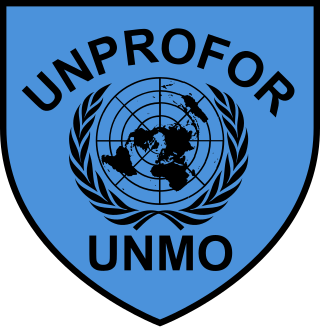| |||||
| Decades: | |||||
|---|---|---|---|---|---|
| See also: | |||||
The following lists events that happened during the year 2006 in Bosnia and Herzegovina .
| |||||
| Decades: | |||||
|---|---|---|---|---|---|
| See also: | |||||
The following lists events that happened during the year 2006 in Bosnia and Herzegovina .

Bosnia and Herzegovina, sometimes known as Bosnia-Herzegovina and informally as Bosnia, is a country in Southeast Europe, situated on the Balkan Peninsula. It borders Serbia to the east, Montenegro to the southeast, and Croatia to the north and southwest. In the south it has a 20 kilometres long coast on the Adriatic Sea, with the town of Neum being its only access to the sea. Bosnia has a moderate continental climate with hot summers and cold, snowy winters. In the central and eastern regions, the geography is mountainous, in the northwest it is moderately hilly, and in the northeast it is predominantly flat. Herzegovina, the smaller, southern region, has a Mediterranean climate and is mostly mountainous. Sarajevo is the capital and the largest city.

Bosnia and Herzegovina has facilities for road, rail and air transport. There are five international road routes and 20 state highways, with bus connections to many countries. Railways total just over 1,000 km with links to Croatia and Serbia. There are 25 airports, seven of them with paved runways. The Sava River is navigable, but its use is limited.

Bosnia and Herzegovina is a country in Southeast Europe on the Balkan Peninsula. It has had permanent settlement since the Neolithic Age. By the early historical period it was inhabited by Illyrians and Celts. Christianity arrived in the 1st century, and by the 4th century the area became part of the Western Roman Empire. Germanic tribes invaded soon after, followed by Slavs in the 6th century.

The Bosnian War was an international armed conflict that took place in Bosnia and Herzegovina between 1992 and 1995. The war is commonly seen as having started on 6 April 1992, following a number of earlier violent incidents. The war ended on 14 December 1995 when the Dayton accords were signed. The main belligerents were the forces of the Republic of Bosnia and Herzegovina, the Republic of Herzeg-Bosnia, and the Republika Srpska, the latter two entities being proto-states led and supplied by Croatia and Serbia, respectively.
Sarajevo is a city now in Bosnia and Herzegovina.

The United Nations Protection Force was the first United Nations peacekeeping force in Croatia and in Bosnia and Herzegovina during the Yugoslav Wars. The force was formed in February 1992 and its mandate ended in March 1995, with the peacekeeping mission restructuring into three other forces.
The Jyllands-Posten Muhammad cartoons were first published by Jyllands-Posten in late September 2005; approximately two weeks later, nearly 3,500 people demonstrated peacefully in Copenhagen. In November, several European newspapers re-published the images, triggering more protests.

Danish newspaper Jyllands-Posten's publication of satirical cartoons of the Islamic prophet Muhammad on September 30, 2005, led to violence, arrests, inter-governmental tension, and debate about the scope of free speech and the place of Muslims in the West. Many Muslims stressed that the image of Muhammad is blasphemous, while many Westerners defended the right of free speech. A number of governments, organizations, and individuals have issued statements defining their stance on the protests or cartoons.

The Croatian Defence Forces were the paramilitary arm of the Croatian Party of Rights (HSP) from 1991 to 1992, during the first stages of the Yugoslav wars. During the Croatian War of Independence, the HOS organised several early companies and participated in Croatia's defence. At the peak of the war in Croatia, the HOS was several battalions in size. The first HOS units were headed by Ante Paradžik, a HSP member who was killed by Croatian police in September 1991. After the November 1991 general mobilisation in Croatia and the January 1992 cease-fire, the HOS was absorbed by the Croatian Army.

The Socialist Republic of Bosnia and Herzegovina, commonly referred to as Socialist Bosnia or simply Bosnia, was one of the six constituent federal states forming the Socialist Federal Republic of Yugoslavia. It was a predecessor of the modern-day Bosnia and Herzegovina, existing between 1945 and 1992, under a number of different formal names, including Democratic Bosnia and Herzegovina (1943–1946) and People's Republic of Bosnia and Herzegovina (1946–1963).

The Jyllands-Posten Muhammad cartoons controversy began after the Danish newspaper Jyllands-Posten published 12 editorial cartoons on 30 September 2005, most of which depicted Muhammad, a principal figure of the religion of Islam. The newspaper announced that this was an attempt to contribute to the debate about criticism of Islam and self-censorship. Muslim groups in Denmark complained, and the issue eventually led to protests around the world, including violence and riots in some Muslim countries.

Nikola Mandić was a Croatian politician and one of the leading political figures in Bosnia and Herzegovina under Austrian-Hungarian rule. He also served as a Prime Minister of the Independent State of Croatia (NDH) during World War II. He was executed by the Yugoslav Partisans as a war criminal on 7 June 1945.

Bosnia and Herzegovina fell under Austro-Hungarian rule in 1878, when the Congress of Berlin approved the occupation of the Bosnia Vilayet, which officially remained part of the Ottoman Empire. Three decades later, in 1908, Austria-Hungary provoked the Bosnian Crisis by formally annexing the occupied zone, establishing the Condominium of Bosnia and Herzegovina under the joint control of Austria and Hungary.

Bakir Izetbegović is a Bosnian politician who served as the 6th Bosniak member of the Presidency of Bosnia and Herzegovina from 2010 to 2018. He is the current president of the Party of Democratic Action (SDA).

The Bosniaks are a South Slavic ethnic group native to the Southeast European historical region of Bosnia, which is today part of Bosnia and Herzegovina, who share a common Bosnian ancestry, culture, history and language. They primarily live in Bosnia, Serbia, Montenegro, Croatia, Kosovo as well as in Austria, Germany, Turkey and Sweden. They also constitute a significant diaspora with several communities across Europe, the Americas and Oceania.

Denmark–Syria relations refers to the bilateral relations between Denmark and Syria. Both countries established diplomatic relations on August 29, 1992. Denmark is represented in Syria through its embassy in Damascus. Following the Jyllands-Posten Muhammad cartoons controversy and subsequent attack on the Danish embassy in 2006, relations between the two countries were greatly strained and later suspended.

Bosnia and Herzegovina–Denmark relations refers to the current and historical relations between Bosnia and Herzegovina and Denmark. Bosnia and Herzegovina has an embassy in Copenhagen, and Denmark has an embassy in Sarajevo. Diplomatic relations were established on 2 June 1992. In 2010, Danish Foreign Minister Lene Espersen announced that Denmark will close their embassy in Sarajevo in 2012.
The Resolution of Sarajevo Muslims or Muslim Resolution of 1941 was one of the Resolutions of Muslims from Bosnia and Herzegovina declared by 108 notable Muslim citizens of Sarajevo during the Second World War in Sarajevo on October 12, 1941.

The anti-Serb riots in Sarajevo consisted of large-scale anti-Serb violence in Sarajevo on 28 and 29 June 1914 after the assassination of Archduke Franz Ferdinand. Encouraged by the Austro-Hungarian government, the violent demonstrations assumed the characteristics of a pogrom, which led to ethnic divisions that were unprecedented in the city's history. Two Serbs were killed on the first day of the demonstrations, and many others were attacked. Numerous houses, shops and institutions owned by Serbs were razed or pillaged.
Around 2:30 p.m. on Sunday, 1 March 1992, a Serb wedding procession in Sarajevo's old Muslim quarter of Baščaršija was attacked, resulting in the death of the father of the groom, Nikola Gardović, and the wounding of a Serbian Orthodox priest. The attack took place on the last day of a controversial referendum on Bosnia and Herzegovina's independence from Yugoslavia, in the early stages of the breakup of Yugoslavia and the Yugoslav Wars.